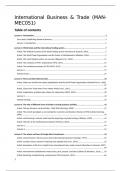International Business & Trade (MAN-
MEC051)
Table of contents
Lecture 1: Introduction................................................................................................................................... 3
Case study: Establishing Honda of America.........................................................................................................3
Lecture 1: Introduction.........................................................................................................................................5
Lecture 2: World trade and the international trading system..........................................................................7
Article: The Political Economy of the World Trading System (Hoekman & Kostecki, 2001).................................7
Article: The World Trade Organization and the Future of Multilateralism (Baldwin, 2016)................................9
Article: The world trading system: an overview (Bagwell et al., 2016)..............................................................11
Article: The evolution of PTAs: stylized facts (WTO, 2011).................................................................................14
Article: The standard economics of PTAs (WTO, 2011)......................................................................................16
Lecture 2.............................................................................................................................................................19
Tutorial lecture...................................................................................................................................................24
Lecture 3: Firms and international trade....................................................................................................... 25
Article: What you should know about globalization and the World Trade Organization (Deardorff et al., 2002)
............................................................................................................................................................................25
Article: Gains from Trade when Firms Matter (Melitz et al., 2012)...................................................................28
Article: Implications of global value chains for trade policy (OECD, 2013)........................................................30
Lecture 3.............................................................................................................................................................33
Tutorial meeting.................................................................................................................................................39
Lecture 4: The why of different forms of border-crossing business activities..................................................41
Article: The key literature on IB activities: 1960-2006 (Dunning, 2008)............................................................41
Article: The eclectic paradigm as an envelope for economic and business theories of MNE activity (Dunning,
2000)..................................................................................................................................................................43
Article: John Dunning’s eclectic model and the beginnings of global strategy (Tallman, 2003)........................45
Article: Theories of the multinational enterprise (Hennart, 2001).....................................................................47
Lecture 4.............................................................................................................................................................49
Tutorial 4............................................................................................................................................................52
Lecture 5: The where and how of foreign direct investment..........................................................................54
Article: Lincoln Electric’s Harsh Lessons from International Expansion (Hastings, 1999)..................................54
Article: Location choice research: Proposing new agenda (Jain et al., 2016)....................................................56
Article: Boundaries of the firm: insights from international entry mode research (Brouthers & Hennart, 2007)
............................................................................................................................................................................60
Article: International establishment mode choice: past, present, and future (Dikova & Brouthers, 2016).......63
Article: Reshoring manufacturing: coming home (The Economist, 2013)..........................................................66
1
, Lecture 5.............................................................................................................................................................68
Paper meeting 1: The (non-) death of distance.............................................................................................75
Article: Has distance died? Evidence from a panel gravity model (Brun et al., 2005).......................................75
Article: There goes gravity: eBay and the death of distance (Lendle et al., 2016).............................................78
Paper meeting 2: Country risks, policy uncertainty, and international investment/divestment......................80
Article: Multinationals’ response to major disasters: how does subsidiary investment vary in response to the
type of disaster and the quality of country governance (Oh & Oetzel, 2011)....................................................80
Article: The impact of EU preferential trade agreements on Foreign Direct Investment (Cadramone &
Scoppola, 2012)..................................................................................................................................................82
Paper meeting 3: Exploiting country dissimilarities.......................................................................................85
Article: Stakeholder pressure on MNEs and the transfer of socially irresponsible practices to subsidiaries
(Surroca et al., 2013)..........................................................................................................................................85
Article: The determinants of tax haven FDI (Jones & Temouri, 2016)................................................................88
2
,Lecture 1: Introduction
Case study: Establishing Honda of America
Systematic analysis
1. What motivated Honda’s decision to establish HAM?
Honda’s decision to establish Honda of America Manufacturing (HAM) was motivated by the
need to enter the American market more effectively. Honda wanted to reduce its reliance on
exports from Japan to the US and overcome the trade barriers and currency exchange rate
risks associated with international trade. Establishing local manufacturing in the US allowed
Honda to be more responsive to the American market’s demands, reduce costs, and gain
competitive advantage.
2. What role did location play in Honda’s decision?
The choice of Ohio as the location for the manufacturing plant was influenced by factors such
as the availability of a skilled and motivated labor force, access to expressways and railroads,
and a level lot covering the required acreage. Ohio’s central location in the US made it an
ideal hub for producing and distributing Honda’s automobiles. Additionally, the state’s
governor, James Rhodes, provided strong support emphasizing the importance of location in
the decision-making process.
3. What are the specific competencies owned by Honda?
Honda possesses several specific competencies, including:
- Expertise in manufacturing high-quality automobiles and motorcycles.
- Strong commitment to quality control and continuous improvement in production
processes.
- Ability to adapt and transfer its manufacturing philosophy and operational outlook to
foreign operations.
- Effective management of its supply chain and development of relationships with local
parts suppliers.
4. What (foreign) activities does Honda do internally and what activities are
outsourced?
Internalization: Honda internalizes key manufacturing and quality control activities, such as
the production of automobiles, motorcycles, and engines. These core manufacturing
processes are conducted internally to ensure quality standards are met.
Outsourced: activities related to parts and components supply.
Motives for FDI and the so-called OLI paradigm
5. What could be some motives for a firm to establish foreign operations?
Tariff-jumping: when a firm invests in local production in a foreign market to jump a tariff on
cross-border exports to the market. One motive for Honda’s FDI could be to avoid high
import tariffs and trade barriers imposed on vehicles and components. By producing locally
in the US, Honda could reduce or eliminate the need to pay tariffs on imported vehicles and
parts.
3
, Internalize exchange rate risks: Honda’s decision to establish manufacturing in the US can
also be seen as a strategy to internalize exchange rate risks. By producing in the local
currency (USD), Honda reduces its exposure to currency fluctuations when selling its
products in the US market.
6. What are the O’s, L’s, and I’s in the Honda case?
Ownership: Honda’s ownership advantage lies in its expertise in manufacturing high-quality
automobiles and motorcycles. This advantage allows them to maintain control over their
production processes and product quality.
Location: the location advantage is represented by Honda’s choice of Ohio as the
manufacturing sited. Ohio’s central location in the US, access to transportation
infrastructure, and availability of a skilled workforce provide location-based advantages.
Internalization: Honda’s decision to establish local manufacturing facilities in the US
represents the internalization of production processes to reduce trade barriers, tariffs, and
exchange rate risks while serving the American market. This internalization allows Honda to
maintain control over its manufacturing operations.
4





